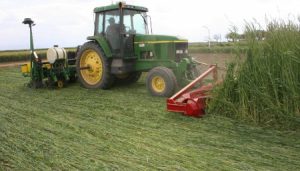Agronomy, Conservation, Homepage Slider
Federal Legislation and Carbon Markets (Part 2)
By Dusty Sonnenberg, CCA, Ohio Field Leader, a project of the Ohio Soybean Council and soybean check-off.
Carbon Credits are a potential revenue source for farmers across the country. In Ohio, it was recently announced that the Soil and Water Outcomes Fund is offering farmers $40 per acre to sign up for their carbon credit agreements if they live in the Upper Scioto River Watershed. “The idea of carbon markets has been around for a long time,” said Peggy Hall, Associate Professor and Field Specialist in Ag Resource Law at The Ohio State University. “About 15 years ago there was a lot of talk about the carbon market and carbon credits, and then it fizzled out. Now the discussion is back again with the concept of the carbon credit. Those agreements establish a market for carbon capture or carbon reduction. The practices that farmers engage in that can reduce greenhouse gasses or sequester carbon can be converted to a carbon credit that can be sold on the open market.”

There is a lot of interest in the carbon market right now. “A number of companies want to have a net zero emissions policy or footprint, and use it for marketing purposes,” said Hall. “They want to be known as net zero emissions and need to purchase these credits to become net carbon zero. That is moving the market along right now.
There are several legal issues that can surround carbon market agreements. “In the legal world right now, we are asking the question: What are they? Are they real property? Are they tangible, are they intangible? Are they personal property? What are these things, and how do we track them in the legal world,” asked Hall. “If there is interest by farmers or landowners to engage in this carbon market, there are a couple of legal issues that need to be considered.”
There are several conditions surrounding participation in these new opportunities. “Be aware that many of the markets have their own rules and eligibility requirements the need to be met from the start,” said Hall. “Farmers need to be careful in selecting a market that they are eligible for, and that the requirements can be met. These requirements may include: geographic location, type of crops to be grown, minimum acreage requirements, and the length of the agreement.”
Another factor to consider in some of the carbon market agreements is the concept of additionality. “Farmers need to understand what practices a carbon agreement is willing to accept and if they need to be new practices, or can be existing management practices in place,” said Hall. “The concept is known as additionality, and it means that a practice needs to be a new carbon generating practice, rather than a practice that is pre-existing. The idea is that it will impact the state of greenhouse gasses moving forward.”
“The concept is known as additionality, and it means that a practice needs to be a new carbon generating practice, rather than a practice that is pre-existing. The idea is that it will impact the state of greenhouse gasses moving forward.”
Landowners need to be aware of and consider the long-term implications of entering into a carbon market agreement. “Some agreements have a specified length of time. Some agreements have a built-in automatic renewal. It needs to be understood, what exactly is being created, and if it could have any impact on the potential future transfer of the land,” said Hall. “A question to be answered is if the agreement is like a lease and transfers with the land or is it a personal property agreement that ends upon the transfer of the land.
A website has been created by the Ohio Soybean Council staff to act as a clearinghouse for all the available carbon market information and simplify the comparison process for Ohio farmers. The information is available by visiting www.soyohio.org and clicking on the “Carbon Markets” tab at the top.